City portrait
There are excellent reasons to spend your holidays in Flensburg – The world has places that provide excellent shopping opportunities, places where you can find your peace and quiet, and others where there is always something going on, as well as convenient places without any particular flair and enchanting places practically without any suitability for daily use. But fortunately, there is Flensburg, because Flensburg can give you a share of every good thing on offer.
About 89,000 inhabitants (as of December 2008), 1,900 hectares of fields, forests and meadows, a fjord connected to the Baltic Sea, a historic city centre, a cosmopolitan appearance as a port city with history and ample space for new inhabitants – that is Flensburg!
Flensburg - The Gateway to the North
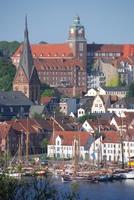 Flensburg lies near the German-Danish border at the end of the approximately 35 km long Flensburg Fjord.
Flensburg lies near the German-Danish border at the end of the approximately 35 km long Flensburg Fjord.Flensburg is a pleasant town with a homely atmosphere; its appeal stems from being a mixture of cosmopolitan harbour and trading port and a place of traditional tranquility, heavily influenced by its close proximity to the water and the meeting of two cultures. 400,000 Germans and Danes live in the immediate neighbourhood with 86,000 in Flensburg itself; the commercial, cultural and tourist centre of the region.
Apart from Flensburg’s role as a maritime centre on the Baltic Sea, the town also has an important function as the gateway to Scandanavia . Several hundred million marks are converted into border trade yearly.
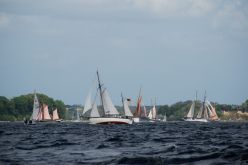
The town provides its visitors with a variety of different leisure activities - relaxation from everyday stress begins right at the front door. First and foremost comes sailing in one of Europe’s most beautiful sailing haunts. Beaches and yachting harbours along the 150 kilometres of German-Danish coastline form an idyllic natural resort to relax in. Numerous yachting harbours along the holiday resort of the Flensburg Fjord, the home of 17 sailing clubs, have not only been the destination of many thousands of visiting sailors in recent years, but have also been the starting-point of many important regattas. Yachts, pleasure boats and ferries ply between the German and Danish shores. The yachting harbour, reserved for visitors allows guests to sail right into the town centre. Over 200 kilometres of wonderful cycle- and footpaths stretch along the coastline of the fjord.
Flensburg excels not only on the water, but also at handball. The SG Flensburg-Handewitt sports club has been at the top of the German handball league and participated in international tournaments for years. Handball enthusiasts in Germany and in neighbouring Denmark know about the “Northern Hell” which is feared by opposing teams.
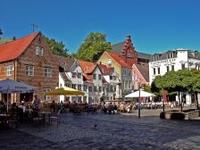
Numerous attractions make Flensburg a popular tourist spot for many German and foreign visitors. It is worth walking through this lively town with its distinctive architecture, simply to look at the extensive restoration of the old town, for which Flensburg is well-known far beyond Germany’s borders. A fresh breeze, high clouds, clean air, the harbour and its trade and centuries of shipping characterize this town on the fjord. For over 400 years Flensburg was ruled by the Danish King and thus is deeply rooted in both German and Danish culture.
After decades of conflict, the Danish minority on this side of the border like the German minority on the other side, co-exists today, in harmonious and fruitful co-operation with the rest of the population. This integrated society, each honouring the other’s cultural identity, is an example for a united Europe. German as well as Danish determines every day life; what more obvious choice was there than Flensburg as the seat of the Europäischen Forschungszentrums für Minderheitenfragen(ECMI - European Centre for Minority Issues). The district councils of Schleswig-Holstein and North Friesia, and Flensburg’s town council on the German side and the district council of South Jutland on the Danish side work in cross-border co-operation to form the «Schleswig-South Jutland Region».
This co-operation and mutual inspiration from different cultures not only make the town particularly attractive, but also allows a wide spectrum of commercial activity.
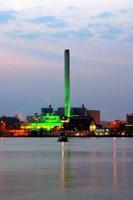
It is not just a centuries-old and flourishing rum and spirits industry, a shipyard on the up and a broad range of service provisions which characterise the face of the city of Flensburg; innovative businesses in the domain of environmentally-oriented technology are increasingly gaining importance. Well-known businesses in cooling and heating technology, electro-technology, news technology, machine engineering, fine mechanical engineering, paper processing, mail order forms and shipping companies have established themselves in Flensburg. In total there are more than 6,000 businesses in Flensburg, with approx. 36,500 full time employees and over 50,000 economically active residents.
The Economic and Regional Development Agency (WIREG) Flensburg/Schleswig along with Flensburg’s and neighbouring councils, support both existent and potential firms. Through close co-operation with Handewitt’s council, it has been possible to establish an industrial estate for the ‘Wirtschaftsentwicklungsgemeinschaft’ (Community of Economic Development) (WEG) Flensburg-Handewitt, for further development of the site.
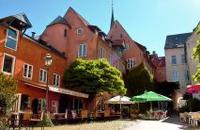
Flensburg is one of the few towns not destroyed during the Second World War. This means that a large number of historic buildings from various periods are still standing. The historic “Old Town”, characteristically German and Danish in its architecture, bears witness to Flensburg’s 700 –year-old history. Under the motto “New Life in Old Courtyards”, the historic lanes and traditional merchants’ courtyards have been transformed into interesting and urban areas full of new experiences. Many small restaurants and boutiques, artisans’ workshops, cafes and galleries have certainly succeeded in bringing new life to these old courtyards.
Between the “Rote Strasse” and the North Gate lies one of the most diversified shopping streets in the whole of the north. This shopping street, which is more than one kilometre long, has about 500 shops and is situated right in the heart of the town, attracting thousands of visitors to Flensburg every summer. ‘Förde Park’ and ‘Citti Park’ (big shopping malls) exist on the outskirts of the town for shopping.
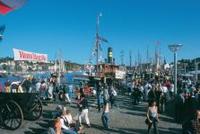
Plenty of cultural activities as well as a pleasant atmosphere can be found in this historic trading town with its old restaurants and cosy pubs. The Schleswig-Holstein Theatre and Symphony Orchestra, the Niederdeutsche Bühne (with performances in Low German) or the “lille teater” (performances in Danish) all offer quality entertainment. In summer the Schleswig-Holstein Music Festival and Flensburg’s ‘Hofkultur’ (Culture in the courtyards) add to the cultural attractions. Flensburg’s residents also know how to have fun. Apart from the traditional “Rum Regatta” sailed by professional sailors and the Flensburg “Old-timer Festival” with old yachts, which are well-known far beyond the town, the particular attraction is the “Dampf-Rundum”, a get-together for old steam-ships and steam engines. Each event draws visitors from the whole of Germany and from elsewhere in Europe.
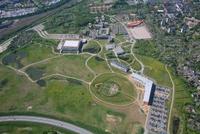
Flensburg possesses an excellent educational range and has developed into a university town of increasing importance. Currently there are around 4,200 students registered at Flensburg University. In addition there are the approximately 3,000 students of the Flensburg Technical College. Altogether these 7,200 students make use of a future-oriented educational range in Flensburg. Amongst other things, at the Technical College they train to be qualified engineers, IT specialists and business economists. The study course “Nautical science and technical ship management ” also located here is one of the most modern study courses in Germany. Flensburg University offers further outstanding study opportunities. Just a few years ago the transnational German-Danish study course “Operational Training and Management” was set up.
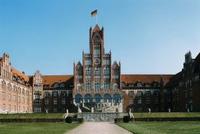
The fleet command in Glücksburg, the Naval College of Telecommunications and the Naval College all have close connections with Flensburg. In the Naval College alone, thousands of naval officers have received training since the beginning of the 20th century.
Who else belongs to the city?
The city of Flensburg has many functions to look after. Therefor they partly build societies for commercial interests. Here you can find a summary who else belongs to the city of Flensburg.
Berufsfeuerwehr
Museumsberg
Schiffahrtsmuseum
Stadtbibliothek
VHS - Volkshochschule
TBZ - Technisches Betriebszentrum
Flensburger Friedhöfe AöR
Regionales Berufsbildungszentrum (RBZ) Eckener-Schule
bequa - Beschäftigungs- und Qualifizierungsgesellschaft Flensburg mbH
FGS - Flensburger Gesellschaft für Stadterneuerung mbH
Stadtwerke Flensburg GmbH
Twin Cities
Carlisle, England
 Carlisle is an English city with a very colourful past. There has been a settlement there for more than 2000 years. The town first gained importance in Roman times and was an important fortress on Hadrian’s Wall. Due to its proximity to the Scottish border, Carlisle retained its importance during Norman times and quickly expanded further. It received a town charter in 1158.
Carlisle is an English city with a very colourful past. There has been a settlement there for more than 2000 years. The town first gained importance in Roman times and was an important fortress on Hadrian’s Wall. Due to its proximity to the Scottish border, Carlisle retained its importance during Norman times and quickly expanded further. It received a town charter in 1158.However, Carlisle became a source of contention between Scotland and England for the following 600 years, which meant that its expansion was constantly interrupted or suffered a set-back. After the defeat of Bonnie Prince Charlie in 1746, Carlisle finally became English.
Since then, Carlisle has profited from its proximity to Scotland and has become an important nodal point. Although this is of much less significance nowadays to the modern Carlisle with around 105,000 inhabitants, it is still an important starting point for tourism in the Lake District to the south-west and in the Scottish Lowlands in the north.
The start of the partnership with Carlisle in the north of England goes back to 1959, when Carlisle expressed an interest in developing a partnership with a town of comparable size in Schleswig-Holstein. The British Council suggested Flensburg.
After further discussions, the first direct contacts were made between the two cities in 1960.
On 29th June 1961, the official twinning was set up during a special session of the Flensburg Town Council with represen-tatives from Carlisle taking part. Shortly afterwards, in July 1961, the regular exchange of young people between the twin towns began, which has remained an important aspect of the twinning ever since.
As the years have gone by, additional contacts have developed, sometimes completely independently of both town councils.

Neubrandenburg, Germany
Neubrandenburg is an independent administrative district in Mecklenburg-Vorpommern with around 67,000 inhabitants.
The twinning was established whilst the city was still part of the German Democratic Republic. It came into being after a decision taken by Flensburg’s town council on 16.11.1987 and Neubrandenburg’s council on 23.11.1987. Flensburg was thus one of fifteen West German towns to form a partnership with a town in the GDR.
The aim of the twinning was to maintain relations between the two German states in order to help overcome the split between them by means of practical co-operation. Cultural exchanges were of prior importance as were shared sports events.
For a while, after unification, the central point of the partnership became giving Neubrandenburg’s town council administrative assistance. Along with an extensive mutual exchange of colleagues, amongst other things, three training courses for employees in Neubrandenburg’s administrative offices were held in Flensburg.
Now that the administrative help has been completed, the main aspect of the twinning is once again the contact between the population of each town, particularly in the form of cultural and sport activities.
Slupsk, Polen
 At the end of the 80’s, Carlisle and Flensburg decided to develop a contact with an East European state and to establish a three-way twinning. At that time relations between Great Britain and Poland were closer, so Carlisle was the one to negotiate with Slupsk, leading later to the ‘Agreement on Mutual Co-operation between Flensburg, Carlisle and Slupsk’ on 29th June 1988.
At the end of the 80’s, Carlisle and Flensburg decided to develop a contact with an East European state and to establish a three-way twinning. At that time relations between Great Britain and Poland were closer, so Carlisle was the one to negotiate with Slupsk, leading later to the ‘Agreement on Mutual Co-operation between Flensburg, Carlisle and Slupsk’ on 29th June 1988.Since then, there have been numerous three-way meetings. Each year an official three-way meeting with a delegation from all three towns takes places in Carlisle, Flensburg and Slupsk in turn, as does a youth exchange.
Status-Quo: Delegation Trip "25 Years Trilateral City Partnership"
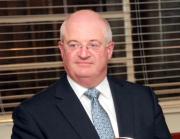
At the invitation of Colin Glover, Leader of the Carlisle City Council (see photo), a delegation of the City of Flensburg travelled to the north of England on 22 August 2013 to celebrate the anniversary of the trilateral partnership of the cities Carlisle (UK), Slupsk (Poland) and Flensburg, but also to steer the partnership in new directions.
The Flensburg Delegation and their Mandate
The delegation consisting of Helge Affeld (Flensburg Youth Association), Helmut Trost (Social Democratic Party of Germany SPD) Christian Dewanger (We-in-Flensburg Voters' Association WiF), Eric Holste (city partnership representative of the City of Flensburg) and Lord Mayor Simon Faber received the mandate to stress the importance of youth exchanges and to strengthen them without increasing the financial burdens on the budgets of the partner cities. In order to achieve this, the Flensburg politicians suggested reducing the frequency of the exchanges that so far took place on a yearly basis.
On site, the delegation received the opportunity to present their mandate, and to point out and discuss additional options for co-operation among the partners.
Preliminary Results Agreed by all Partners
- The delegations agreed to the high importance of youth exchanges and it was decided to extend the length of the stays of 10 - 14 exchange students for each partner city to a minimum stay of "10 days in the partner city".
- Equally, it was agreed to look into the suggestion made by the Polish delegation from Slupsk, which introduced the option of founding an EU-funded society in order to finance the trilateral youth exchange programme.
- Furthermore, the delegations from Slupsk and Carlisle expressed the wish to continue the delegation trips at least every 2 years, as otherwise the contact among the partners, always so important for decisions, might be lost.
Conclusion of the Flensburg Politicians in the Delegation
Subsequently, the political part of the Flensburg delegation emphasized the importance of the decision concerning the youth exchange and promised financial support for its future implementation.
Highlights of the programme: Youth Zone, College, Civic Dinner

After these constructive talks, the delegations were shown around the Carlisle College that trains young people in various professional fields. The building, which is at present being modernized, has received rooms for the professional fields "massage", "make up", "nail care" and "hairdressing" in this latest, only recently finished construction phase. These rooms may be used by the students professionally outside school hours, so they can take their first steps to professional independence already during their training, but under realistic conditions.
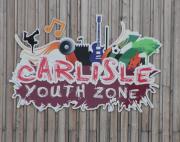
The delegates also visited the Carlisle Youth Zone. This is an institution that offers various options of use for adolescents: The young people can spend their free time there, do sports or even write job applications on one of two the Apple computers provided there. In part, the young people contribute to the costs of the Youth Zone themselves. They pay around € 6 per year plus 60 cents for every day on which they actually use the Youth Zone.
Alongside these activities that centre very much on the young people, the delegations from Flensburg and Slupsk were involved in the yearly Declaration of Market Rights and the sermon held for that occasion.
The delegations received a good insight into the economic development of Carlisle during their trip and they were shown manifold cultural impressions and the large touristic potential.
At the traditional Civic Dinner, the heads of the delegations again emphasized the decisions made and handed over their presents on the occasion of the 25th anniversary.
Impressions during the Exchange of Presents
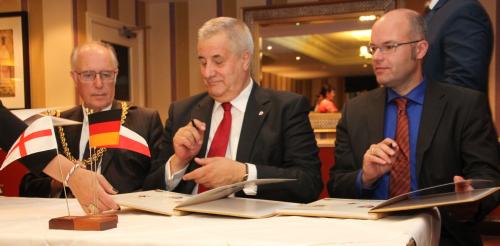
Mayor Bloxham (Carlisle), City President Kobylinski (Slupsk) and Lord Mayor Faber signing the illustrated book created by Poland for the 25th anniversary of the partnership.
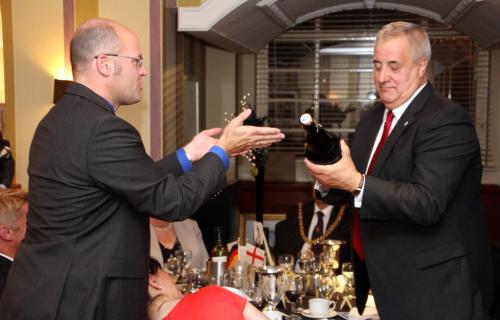
City President Kobylinski (Slupsk) examining the noble drink in the typical Flensburg bottle. Magical Fireworks over Carlisle Castle: Head of Council Glover presents the gift that from that moment on has added a colourful touch to the Carlisle Room in the City Hall in Flensburg.
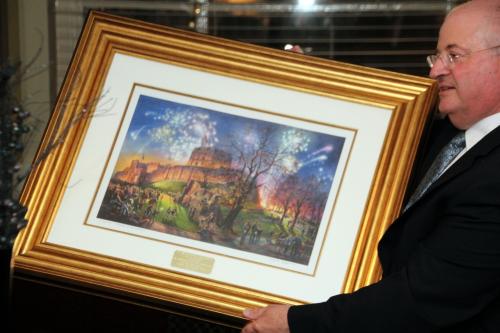
Magical Fireworks over Carlisle Castle: Head of Council Glover presents the gift that from that moment on has added a colourful touch to the Carlisle Room in the City Hall in Flensburg.
City History
It may be that dinosaurs played here and that later Harald Bluetooth's Viking ship ploughed through the Flensburg Fjord. We don’t know for sure – ever since historical times the old Heerweg (ancient military trail), also called Ochsenweg, has connected Jutland with the European heartland from north to south, and crossed the trade route from Angeln to Friesland in front of the gates of the city of Flensburg. Where streets and sea meet is an ideal place for settlements. And so, in the innermost corner of Flensburg Fjord, a trading settlement grew up around the oldest church, St. Johannis. According to legend, in the 12th century the knight Fleno built his fortified city here and demanded money from tradespeople passing through.
If you would like to find out more about the history of Flensburg, search for traces of your ancestors in Flensburg, or if you are interested in German-Danish history, then visit the Flensburg city archive. You can look at original documents and obtain information and tips on further reading. The city archive can be found in the Flensburg city hall.
You will find a tabular display about the development of the city and its national political background in the "Chronology of the history of Flensburg" ("Zeittafel zur Flensburger Stadtgeschichte"), which appears in "Flensburg in Geschichte und Gegenwart" ("Flensburg Past and Present"), 1972, page 385 onwards. (For a short version of the background to the city‘s history see: "700 Jahre Flensburg - eine kleine Stadtgeschichte" ("700 years of Flensburg – a brief history of the city"), Flensburg Kl.R.F.St. Edition11, 1984). Recording of recent years and also constant updating are done in consultation with the city archive.
before 1200 - 1499
Flensburg received the town charter in 1284 from Duke Waldemar IV. At the same time the building of what is now St. Mary’s Church and the sit of ‘Nordermarkt’ (North market place) was begun, with St. Nikolai’s Church at ‘Südermarkt’ (South Market Place) a hundred years later. Between these two central points where the town theatre now stands was a thingstead where the population of the town would gather to discuss usiness under the open sky. In 1345, the town built a wall around itself with the main gates being the former North Gate, the Friesian Gate and St. John’s Gate at the roads of the old main streets leading in form the merchant highways.
The rivalry over the dukedom of Schleswig, which had continued since the 13th century, led to the building of the Duborg under Queen Margarethe of Denmark at the beginning of the 15th century. When in 1460 Schleswig-Holstein’s councillors in Ripen (Ribe) elected King Christian I of Denmark as Duke of Schleswig and Count of Holstein, Schleswig-Holstein’s fate was sealed for centuries. The King of Denmark was Regent over Flensburg in his capacity as the elected Duke of Schleswig.
Tabellarische Darstellung:
| vor 1200 |
• Flensburg is a small trading post (called Köbing) in Denmark whose function is mainly to transfer goods from the North to the Baltic Sea; as a small trading place alongside the merchant town, Schleswig. |
| ca. 1170 |
• A central urban settlement is established round St Johannis’ Church. It is conceivable that one or two small settlements were built near the St Marien Church. |
| ca. 1200 |
• The market settlement (St Marien) is built, modelled on the founding Hanseatic town. Flensburg is thus one of the many inaugurative towns at the time when Denmark was a great power under the ‘Waldemars’, who commanded the Baltic Sea and also the trading between the North Sea and the Baltic, particularly after having conquered Lübeck and Hamburg for a time. |
| 1232 |
• Prince Abel becomes Duke of Schleswig. After his father’s death, in 1241, the Duke carries out policies friendly to the Hansa. Flensburg is influenced by the Hansa, with Stralsund, Wismar and Lübeck becoming particularly important trading partners. |
| 1240 |
• First documented mention of the town. |
| ca. 1240-1280 |
• Establishment of St. Nikolai parish round the South Market (Südermarkt). |
| 1263 |
• Founding of the Franciscan cloisters (now the old peoples’ home ‘Cloister to the Holy Spirit’). |
| 1282 |
• Schleswig and Flensburg sign an agreement to end their commercial rivalry and to pursue a policy of co-operative trading. |
| 1284 |
• Confirmation of Schleswig’s town charter by Duke Waldemar IV. Flensburg receives the town charter. |
| 1386 |
• Inherited feifdom is granted to Count Gerhard VI of Holstein with the Dukedom of Schleswig by Queen Margarethe I of Denmark. The Schauenburg trading policies, which need to be seen as in close co-operation with Lübeck, has already been of significance to Flensburg since 1325. |
| 1388 |
• Flensburg loses its village character. The council passes an edict that houses must be roofed with tiles instead of straw. |
| 1398 |
• Duke Gerhard VI sells the ‘Rude’, which since then has formed the southern part of the town, to Flensburg. |
| 1409 |
• Queen Margarethe I and King Erich receive Flensburg as security. |
| 1409-1435 |
• War between the Danish Royal House and the Schauenburg Counts, who are supported by the Hansa towns to secure the Dukedom of Schleswig. Flensburg is in the centre of this conflict and is badly damaged. |
| 1411 |
• King Erich has the Duburg built to secure the monarchy (relinquished 1719). |
| 1412 |
• Flensburg’s City Parliament swears the oath of allegiance to Queen Margarethe I. of Denmark. |
| 1431 |
• The Duburg surrenders to the Schauenburgers. |
| 1435 |
• In the treaty of Vordingborg Duke Adolf VIII of Holstein is granted the Dukedom of Schleswig as an inherited fiefdom. |
| 1443 |
• Construction of the old town hall in the Rathausstraße (Town Hall Street). |
| 1460 |
• King Christian I of Denmark of the House of Oldenburg is elected Duke of Schleswig and Count of Holstein by the Schleswig-Holstein nobility. For Flensburg this means independence from Lübeck’s commercial supremacy and – until 1627 – the promotion to the status of most important trading town among the countries of the Danish Union, which comprises what are now Denmark, Sweden (until 1521), Norway (till 1814) and Schleswig-Holstein (till 1864). |
| 1480 |
• The town is permitted to charge a harbour fee. |
1500 - 1799
With the support of the Danish crown, Flensburg temporarily inherited the Hansa in Denmark and Norway. In the 16th century Flensburg grew into a rich and important trading town and, with 5,000 inhabitants and 200 ships, it was the largest trading centre of the Danish crown, larger and more important than either Hamburg or Copenhagen at the time. Wealthy citizens donated costly gifts to the churches of St. Mary and St. Nikolai. The North Gate, the Market Hall (Schrangen) and the Company Gate (Kompagnie Tor), used as the sailors’ mission, all date from this period. Due to the 30-year war, 1618-1648, and the northern wars, 1712 – 1721, in Schleswig-Holstein, a rapid demise then set in. Wallenstein’s troops occupied Flensburg in 1627, followed by the Swedes in 1653 and 1657, the great electoral prince in 1658 and then the Swedes again in 1713. By the time the reconstruction of the frequently sacked town became feasible in 1721, Copenhagen and Hamburg had long outstripped Flensburg. Now it had a fleet of only nine ships and the harbour was silted up.
The basis for a laborious reconstruction can be found particularly in the trade with Norway. Flensburg’s ships transported agricultural products there, loaded fish and fish oil for the Baltic Sea ports as far as St Petersburg and extended their trading partnerships to France and Spain. At the end of the 18th century, under the prerogative of the Danish King Christian VII, ships sailed as far as the West Indies bringing back sugar cane, tobacco and rum as semi-finished products to be processed in Flensburg.
In 1795 Flensburg’s merchant fleet had 295 ships again. But Denmark, as the monarch of both states, took a fatal decision in supporting Napoleon at the beginning of the 19th century, lost Norway at his defeat, and as a consequence of the Continental System, Flensburg lost not only its trading partner but also nearly all its merchant vessels.
Tabellarische Darstellung:
| 1508 |
• The town has 422 inhabited plots of land. |
| 1526 |
• The Reformation. The town has influence over schooling. |
| 1544 |
• King Christian III establishes a mint in Flensburg. (From 1350 – 1776, the valid currency in Flensburg is that of Lübeck). |
| 1551 |
• The Franciscan monastery St. Katharinen, the leper hospital St. Jürgen and other foundations are joined together to form the ‘Cloisters to the Holy Spirit’, which receives its own jurisdiction and administrative sovereignty. |
| 1558 |
• Policing decree: an urban constitution regulating the town walls, the bridge, the tradesmen, boatsmen, brewing, baking, slaughtering etc. |
| 1566 |
• The Latin school ‘Altes Gymanasium’ is founded. |
| 1573 |
• Flensburg falls out with Husum. This means the end of long and mutually advantageous co-operation in North to Baltic Sea trading. |
| 1590 |
• ‘Neustadt’ (Newtown), the district which later became the Johannis and Jürgen Streets, beyond the Angelburg Gate. |
| 1595 |
• Construction of the Market Hall (Schrangen) at the North Market by the parish of St. Marien. |
| 1601 |
• Town boundaries laid down. The demarcation stones used have mostly remained in situ till today. |
| 1602 |
• Construction of the Company gate with the town weighbridge. |
| 1606 |
• Construction of a thoroughfare to the south, what is now the ‘Rote Strasse’ and the street towards Schleswig and the construction of the ‘Red Gate’, demolished in 1874. |
| 1626-1721 |
• The century marked by war. Flensburg loses its commercial importance to the benefit of Copenhagen and Hamburg. |
| 1734 |
• Establishment of the Flensburger ‘Commercium’, a fore-runner of the Chamber of Commerce. |
| 1749 |
• Foundation of a Greenlandic Company for Whaling and Sealing. |
| 1766 |
• Discontinuation of the collective agricultural community and incorporation into urban fields. |
| 1769 |
• Beginning of voyages to the West Indies. |
| 1792 |
• Flensburg has ca. 11,500 inhabitants. |
| 1795 |
• Inauguration of a theatre. |
| 1796 |
• Permission to build beyond the North Gate (Nordertor), 1797 building construction started on the Neustadt (Newtown) (previously Ramsharde). |
1800 - 1899
At the start of the 19th century, the question of nationality led to hefty conflicts between those loyal to Schleswig-Holstein and those who wished to remain under Denmark’s state rule. This resulted in the Schleswig-Holstein Uprising (1848-1851) and the German-Danish War (1864), which were fought out on the battle-fileds of Oeversee and Düppel. Schleswig-Holstein was annexed as a province to the Prussian Kingdom and in 1871 became part of the German Empire.
Tabellarische Darstellung:
| 1806 |
• Height of Flensburg’s commercial shipping with 271 ships and ca. 15,000 loads of freight. Severe commercial set-back due to the Napoleonic Wars and as a result of Norway’s cession to Sweden (1814). |
| 1813 |
• Establishment of a central cemetery for all the town’s churches – today’s ‘Alter Friedhof’ (the ‘Old Cemetery’), the first communal cemetery north of Göttingen. |
| 1832 |
• The first steam engine is put into operation at N.F. Friedrichsen’s oil mill at 15, Neustadt. |
| 1833 |
• The new normative is put into force, dealing with the members of the municipal authority and the councillors, and which confers more powers on the councillors. |
| 1848-1851 |
• Schleswig-Holstein revolution (known to the Danes as the ‘Three-Year War’). Schleswig-Holstein demands independence as far as the Königsau as part of Germany while the nationalist Danes demand annexation as far as the Eider. After the Danes’ victory, Flensburg becomes capital of the Dukedom of Schleswig from 1851-1864. |
| 1854 |
• Gasworks set up. |
| 1856 |
• Construction of the ‘English Bridge’ for the transfer of goods brought by rail from the North Sea onto steamers on the Baltic. |
| 1857 |
• World recession. Flensburg’s traditional commercial structures are destroyed by bankruptcies. |
| 1863 |
• Contrary to the agreements signed in the ‘London Protocol’, the Dukedom of Schleswig and the Kingdom of Denmark join to become a federative state. |
| 1864 |
• The German government intervenes to restore the status quo. Prussia and Austria march into Schleswig and Jutland. After the Prussian conquest of the Düppel trenches, Denmark has to cede Schleswig and Holstein to Austria and Prussia. |
| 1866 |
• Fjord steamers are run for the first time by the Flensburg – Ekensund Steamer Company. |
| 1867 |
• Schleswig-Holstein is incorporated into Prussia. The interior customs point on the Königsau becomes the state border; the state border on the Elbe is abolished. This creates great economic problems for Flensburg, which are solved during the course of the 70’s (after the foundation of the Prussian Empire in 1871). |
| 1869 |
• Introduction of Prussian civic laws. |
| 1870 |
• Setting-up of the Chamber of Commerce. |
| 1872 |
• Founding of Flensburg’s Shipbuilding Company. |
| 1873 |
• Establishment of voluntary fire-brigade. |
| 1874 |
• Opening of the Diakonieanstalt (Flensburg’s second hospital). |
| 1875 |
• Agriculture College opened. |
| 1877 |
• Navigation College built at Munketoft. |
| 1878 |
• Flensburg’s Workers’ Housing Club founded as the first German Workers’ Housing Association. |
| 1881 |
• Opening of the central post office in the Rathausstraße. |
| 1882 |
• The waterworks is put into operation. |
| 1883 |
• The old Town Hall is demolished. The town council and administration move into the provisional Town Hall (Holm 7) until 1964. |
| 1884 |
• A city intercom system with 26 terminals is put into operation. |
| 1886 |
• The College for Nautical Engineering, later to become the University of Applied Sciences, is founded. |
| 1888 |
• The establishment of Flensburg’s export brewery. |
| 1889 |
• Flensburg becomes an administrative district in its own right. |
| 1894 |
• The first electricity plant is put into operation. |
| 1899 |
• The slaughter house is opened. |
1900 - 1945
The outcome of World War I hit Flensburg hard. After a referendum, the present border was fixed in 1920. North Schleswig became part of Denmark and Flensburg, a border town. Fewer bombs fell on Flensburg than on comparable cities during World War II so that Flensburg remained practically intact. However the refugee situation after the war and later was terrible. The final government fled as far as here and had it´s last seat in Flensburg. The government under Großadmiral Dönitz declared the capitulation and the end of the Third Reich from the Naval College in Mürwik on 7th May 1945.
Tabellarische Darstellung:
| 1900 |
• The foundation of the Trade Corporation. |
| 1903 |
• Arts and crafts museum opened. |
| 1904 |
• Setting up of professional fire-brigade. |
| 1907 |
• Tram lines switched to electricity. |
| 1910 |
• The Mürwik Naval College is opened. |
| 1911 |
• Inauguration of the ‘Friedenshügel’ cemetery. |
| 1912 |
• Construction of a new electricity plant. |
| 1914-1918 |
• First World war. |
| 1918 |
• Germany becomes Republic. |
| 1919-1920 |
• Referendum in Dukedom of Schleswig. The first zone (North Schleswig) votes in an en-bloc election for Denmark, which receives 75% of the vote. On 14th March there is an election commune by commune in the second zone and in Flensburg. Flensburg decides with 75% of the vote to remain in Germany. The new border is drawn 5 km north of Flensburg. The economic consequences are serious. Flensburg loses almost half its sales area. The loss in turnover in Flensburg is on average about 30%. The town stagnates in the following years. |
| 1922 |
• Opening of the first sewage plant on the Lautrup brook (until 1963). |
| 1923 |
• Opening of the free harbour (closed 1935). |
| 1925 |
• Opening of the Schäferhaus airport. |
| 1926 |
• Opening of the 'Seegrenzschlachthofs' (until 1973). |
| 1927 |
• The inauguration of the stadium at Kielsenger Feld. |
| 1928 |
• Radio mast put into operation. |
| 1929 |
• Beginning of the world recession. Flensburg is badly affected due to its economic weakness. In 1930 an increasing number of ships lie at anchor in the harbour. The Flensburg Shipbuilding Company (FSG) ceases to operate (until 1934). In 1930 there are 6,000 unemployed. The town’s welfare costs increase six-fold in comparison with 1913. In the same year the number of oaths of disclosure increases three-fold in comparison with 1924. The paper –processing plant closes temporarily. The number of unemployed reaches about 9,000. |
| 1930 |
• Opening of the ‘Deutsches Haus’. |
| 1931 |
• The central bus station – the first of its kind on Germany – is put into operation. |
| 1933 |
• The Nazis seize power, beginning of the Nazi dictatorship. |
| 1935 |
• Renewal of a large part of the harbour bulwark. |
| 1935-1937 |
• Founding of a Torpedo and Communications College in Flensburg-Mürwik (today: the Naval base and Telecommunications College). |
| 1936 |
• Construction of the tank barracks (Meiereistraße) |
| 1938 |
• Building of the barracks on the Danish border. |
| 1939 |
• Census. The population reaches 70,871. |
| 1939-1945 |
• Second World war. |
| 1945 |
• In May Flensburg and the ‘restricted area’ Mürwik round the Naval College is the refuge for several thousand members of the party, state and army. |
1946 - 1989
The post-war years were marked by reconstruction and good relations with Denmark and the whole of Scandinavia. The co-existence of Denmark and Germany with their minorities on each side of the border has become a model for the Europe of the future.
Tabellarische Darstellung:
| 1945-1970 |
• The consequences of the Nazi dictatorship and the war are long evident in the spiritual and moral collapse of Germany, the start of a new democracy and the formation of a strong Danish minority, with short-term evidence noticeable in the economic collapse and the stream of refugees and exiles. |
| 1946 |
• Inauguration of the College of Further Education. |
| 1950 |
• Inauguration of a radio station (NWDR) next to the Deutsches Haus. |
| 1952 |
• The federal office for the registration of vehicles is transferred from Bielefeld to Flensburg. |
| 1953 |
• The district railway (the local line Flensburg – Kappeln is closed). |
| 1958 |
• A branch of Danfoss starts production. It is the most important of a number of Danish firms, which get established just south of the border within the sphere of the Common Market; partly in Flensburg and partly in Harrislee. |
| 1961 |
• Census. After the programme to re-allocate refugees, in the fifties, the population sinks to 98,464. |
| 1962 |
• The water tower in the Volkspark and the new sewage plant Kielseng are put into operation. |
| 1964 |
• The new Town Hall at ‘Pferdewasser’ is finished. |
| 1965 |
• The federal office for the registration of vehicles moves to a new building in Mürwik. |
| 1967 |
• Opening of the sports hall for the Danish minority: the ‘Idraetshallen’ in the Moltkestraße. |
| 1968 |
• Completion of the west by-pass (till 1987 BAB 205, now BAB 200). |
| 1969 |
• The first supplies of district heating from the Department of Works. |
| 1970 |
• Census from 27.5.: 95,476 inhabitants. |
| 1973 |
• Inauguration of the waste processing plant to turn garbage into compost. |
| 1975 |
• The first sod for the new building of the University of Applied Sciences is turned (the new buildings in the Kanzleistraße). |
| 1976 |
• The pedestrian precinct is extended to the ‘Große Straße’ and to the Norderstraße where a minimum of traffic is allowed. |
| 1978 |
• Opening of the section of the BAB 7 motorway between Jagel and Denmark including the border point ‘Ellund’. |
| 1979 |
• The first buildings completed for the University of Applied Sciences in the Kanzleistraße are put into use. |
| 1980 |
• Building construction for a school centre at the Nikolaistrasse/Zur Exe begins (now known as the ‘Friesische Lücke’). |
| 1981 |
• The central post office in the Bahnhofstraße is completed. |
| 1983-1987 |
• After the oil crisis 1973/1974, the increase in oil prices causes global economic weakness, which hits Flensburg particularly hard as well as long-term owing to the imbalance of its commercial structure. The number of unemployed in the town steadily increases until 1987 to over 17%, which is more than 6,000 people. Nearly 45% of the town’s budget is needed for welfare payments. The municipal authorities order restrictions in the budget on many occasions. |
| 1983 |
• The new road lay-out for the B200 – with the south motorway junction – is opened. |
| 1984 |
• New buildings of the civic nursing home ‘Valentinerhof’ are opened. |
| 1985 |
• The ‘Northern University’ is founded, running as a private enterprise. (1989 closed by the Schleswig-Holstein government.) |
| 1986 |
• The first shopping arcade (Holm-Passage) is opened. |
| 1987 |
• Census of 25.5.: 86,554 inhabitants. |
| 1988 |
• A large extension to the University of Applied Sciences is opened. |
| 1989 |
• The new 215-metre transmission mast on the ‘Fuchsberg’ in the district of Engelsby is put into operation. (The previous 216 metre mast in the district of Fruerlund is taken down in 1989/90.) |
1990 - 2011
The first citizens' initiative with subsequent referendum is carried out. The reduction of army units in the course of the disarmament agreements begins in 1993, and Flensburg is affected by this to a high degree. In 1999, there is the first direct election of the Lord Mayor. Also, the handball team SG Flensburg-Handewitt wins the first German Handball Championship Title in 2004.
In December 2006, the cities of Flensburg and Glücksburg sign the contract for the Administrative Union Flensburg-Glücksburg, which comes into effect on 1 January 2008. In August 2007, Flensburg is badly hit: Motorola outsources its logistics section – 650 employees are affected by this. In May 2008, there are communal elections: the voters' association "We in Flensburg" (WiF) is elected into the council as the strongest group with 10 seats and nominates the City President. In July 2008, the financial institutions Flensburger Sparkasse und Nord-Ostsee-Sparkasse merge to form the new Nord-Ostsee-Sparkasse (Nospa).
Tabellarische Darstellung:
| 1990 |
• The ‘South Clinic’ for geriatrics is closed down. |
| 1992 |
• The integrated comprehensive school founded. The secondary modern school on the east of the town starts the gradual year by year process of closing down. |
| 1993 |
• First general election for the senior citizens’ committee. |
| 1994 |
• The College of Further Education becomes the ‘University for Educational Sciences’. |
| 1995 |
• Opening of the North Arcade in the Norderfischerstraße. |
| 1996 |
• Establishment of the European Centre for Minority Issues in the Kompagnietor. |
| 1997 |
• The Women and Children’s Clinic is taken over by the ‘Diakonie’ Hospital. |
| 1998 |
• The new bus station is completed. |
| 1999 |
• First direct election for mayor; two ballots, on 13 June and run-off vote on 4 July. |
| 2000 |
• Start of the second building phase of the Osttangente. |
| 2001 |
• The Flensburg Motorola plant remains. |
| 2002 |
• Flensburg becomes the domicile for the 'Schule für Strategische Aufklärung' in the former telecommunication school – Federal President Johannes Rau visits Flensburg. |
| 2003 |
• Official opening of the new centre in what was 'Hotel Europa' (now 'Europa-Haus') with tourist information, mobility office, taxi office and Stadtwerke customer service centre. |
| 2004 |
• SG Flensburg-Handewitt wins the handball league for the first time. |
| 2005 |
• Inauguration of the mayor Klaus Tscheuschner. |
| 2006 |
• October: formal opening of the Osttangente. |
| 2007 |
• February: Opening of the Walzenmühle. |
| 2008 |
• Area of city: 5,674.2 hectares; increase due to buying land from Tastrup. |
| 2009 |
• Flensburg celebrates its 725th city anniversary with a historic harbour festival and many other events. The city hall welcomes all citizens for an open day on 13 September. |
| 2010 |
• 26 March: Opening of the new Campusbad swimming hall. |
| 2011 |
• 16 January: Inauguration of Lord Mayor Simon Faber. |
